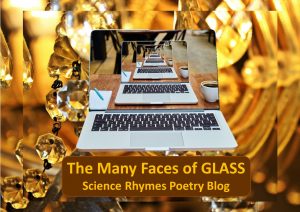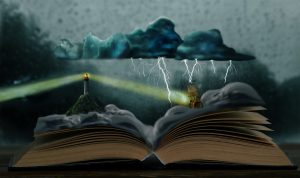We have fourteen poems in celebration of National Science Week 2022 – GLASS: more than meets the eye. Congratulations to all the poets who kindly participated, sharing their words of intrigue, history, science and beauty. Please enjoy!
Glass
by Rylee (Gunnedah South Public School)Glass can easily smash
Glass can break in a dashPeople use glass for mugs
But it’s not for pugs or bugsIt is used to make lots of jars
And there’s actually glass on Mars!
Corners that meet the eye
by MichaelaGlass
in the four corners
that meet the eye.Rooms
filled with the
reflection of yourself
show who you really are.Formed
with tiny pieces of sand with
the minerals changing its
colour in every corner.Cracks
consume the many faces
like thunder and
lightning striking them.
And everything in its pathslowly builds it up again
but not as strong and
solid as before. These
are the faces, the many
faces that meet the eye.
Mirror: more than meets the eye
by KseniaFrom one angle of the mirror,
a young girl is studying.
From another,
an adult is partying.Only one thing can affect our decisions,
one thing becomes a guide.Our Mind.
Where we store dreams, hopes,
things we want no one to know.Yet, it has
more secrets of its own.More…
than we will ever know.
Glasswork Skin
by Jasmine (St Thomas Moore College, Sunnybank, QLD)I am a stained glass terrarium.
From the outside looking in
my organs float,
structured with nature’s perfection
which is to say
exquisitely organised.The glass itself is
streaked with human touch:
fingerprinted with ridges
fogged-up with breath
feverishly wiped
and repeated.This body of mine is fragile
beautiful, in theory
vulnerable, in reality
every scratch is disillusion,
making me undeniably
still life.
Cloak and Dagger
by Cheryl PolonskiGlass manufacture goes back a long way.
The skill was a secret, they kept it that way.
It appears that the knack from the Middle East came,
but when it reached Venice things weren’t quite the same.1200 AD saw the Syrian men,
come under the rule of the Council of Ten.
The Venice Republic security arm,
made sure that the craftsmen would come to no harm.When furnaces failed and caused fires uncontrolled,
they’d move to an island the craftsmen were told.
Because all the knowledge was fiercely protected,
what happened there next was still not unexpected.The glassmakers stayed under threats to their lives.
This involved all their family including their wives.
They never could leave but were somewhat rewarded,
with several benefits being afforded.The glassblowers’ daughters could marry nobility,
bestowing upon them a sense of tranquillity
Producing the best of all glass on display,
the fame of Murano exists to this day.
The Art of Glass
by Sophia HealdgroveThe sandy mineral silica
makes stained glass for the basilica.Melted with other elements
its colours and hues are brightly intense.Hot glowing balls of fiery glass
Used in making scientist’s Erlenmeyer flasks.Beautiful bowls, moulded and curved
a delight on which food can be served.For hundreds of years, glass artisans toiled
As the glass in their furnaces boiledThey created such delicate works of wonder.
But recently trade began to go under.The German city of Hamelin
has one glasshouse where many had been.Machines taking over from made by man
will never achieve what humans can.The craft of glass-making is precious and rare.
Hand-made, beautiful, intricate glassware.So let us conserve this beautiful art.
Please trust that I give these words from the heart.
Humble Beginnings
by Cheryl PolonskiA natural glass was once found on the land
near the mouths of volcanoes which melted the sand.
Those obsidian pieces were sharper you see,
than anything else in 4,000 BC.Our stone-age ancestors then used them for spears.
The benefits recognised down through the years.
For surgeries stainless steel scalpels are made,
but some still prefer an obsidian blade.The earliest use was for jewellery and beads,
but soon ‘twas discovered, glass filled other needs.
By focussing through a shard, rays of the sun,
the lighting of fires was easily done.When open wounds threatened life, it was thought wise
to make use of this method and thus cauterise.
The heat focussed through the glass stopped the blood seep.
Experimentation then took quite a leap.So from humble beginnings there was such a race
for this startling discov’ry to find its true place.
In just about every conceivable science,
there is upon glass a specific reliance.
Curious Sand
by Toni NewellOn a stormy night
If lightning strikes sand
Glass can be formed
On the beach unplanned.
Making glass commercially
Comes in many shapes
Can be a glass or a vase
Even a bowl of grapes.
Just add a few minerals
To make it coloured glass
Formed into a different shape
Sand of a different class.
Mystic Glass
by Toni NewellWalking on the beach
Beneath our feet is sand
However those little grains
Can become a glass in hand.
Sand, lime and soda ash
Using extreme heat
Can form many objects
From which we drink and eat.
It can take a million years
For glass to decompose
That’s why we should recycle
And save our planet woes.
Prince Rupert’s Drop
by Myra KingThere is a strange phenomenon,
that many may not know,
it’s a drop of glass, a rounded shape,
from firing’s heating glow.Prince Rupert’s Drop a splendid name
in royal connotation
has a strength that’s way beyond
most imagination.It can’t be wrecked or smashed by hand
in any way or form
but a fragile state belies its fate
way outside the norm.Rupert’s Drop’s Achilles’ heel
is its tail long and thin
and if this is snapped the tension’s broke
from just beneath its skin.A million pieces shatter
to burst the lovely drop
it all happens in an instant
in one explosive pop!
Glassical Music
by Sukarma TharejaFine glassy goblets for dinner wine
when gently tapped, will tinkle and chime.
If rubbed with damp fingers around their rim,
like an upside-down bell, they start to ring.Their shape and their size dictate how each hums.
Large empty glasses might groan like a drum.
Pour in some liquid to make their pitch higher.
Together they’ll sound like an eerie choir!
GLASS for the CLASS
by Stefan NicholsonYou are tough and often stand guard within a frame,
Like as a window, or fronting a picture,
Or focussing our gaze, when our eyes are not the same.
And I often see through you, unless disguised by your coating,
Put on to dull your amorphous transparent mixture,
Of soda, silica, limestone and ‘fancier’ bits, you often say when gloating.And it’s obsidian to say that you can’t be naturally found,
A universal secret without human intervention.
And your boast about rapid cooling makes my blood boil,
For when you were made, you were just too hot to handle,
Making parched lungs wait, for when you were of malleable intention,
Else creating such strange objects, as if made by a mischievous vandal.Yet, I am overwhelmed by the stresses that you quietly hide
Within your new shape or moulded design,
Made whilst gooey like molten plastic, where no animal can abide.
Which makes for great fun when a glass animal is ‘born’
And you see its wonders in detail and colours and lines
Made by us humans, as we’ve been doing from time’s early dawn.As an art, you are an object of delight in many ways,
Mimicking nature, abstract designs and useful objects to name a few.
Modern buildings tease out new conceptual uses for your display,
Fish swim within your bounds and plants bathe in wind-less sunshine.
You protect and make for easy cleaning – to let us enjoy a safer view
From the sky, on the water, where we can watch the world as we dine.Broken items can be accidental and there is none more dangerous than glass,
With your warped sharp edges and shards that can stick you like a pin.
But no blame to you, as QA have given you a ‘pass’.
And your character can now be changed, by material science at its best,
To make you stronger, withstand heat and shock, and be made ultra-thin
But I wish that people knew you better, not as a product, but as our guest.
Handle Me With Care
by Sukarma Thareja & Celia BerrellSea-shore sand and potash, soda,
made my common sturdy solid.
Crafted since Egyptian times,
my structure is non-crystalline.My recipes of compound chemicals
make me practical and beautiful.
Sometimes heat-resistant, durable,
always totally recyclable.Many of my forms are brittle.
Shattered shards of glassy needles
hurt and harm. They stab and tear.
So handle me with care. Beware!
Aliens in the Atacama Desert
by Celia BerrellThis desert is dotted
with dark green glass
that came from an alien …
space rock blast!Punching through air
so incredibly fast,
pressure, heat, friction
became so vast
the silica sand
on the desert below
melted to glass
as that comet explodes.These alien minerals
scattered the scene,
which seems to have made
those glassy shards green.


































